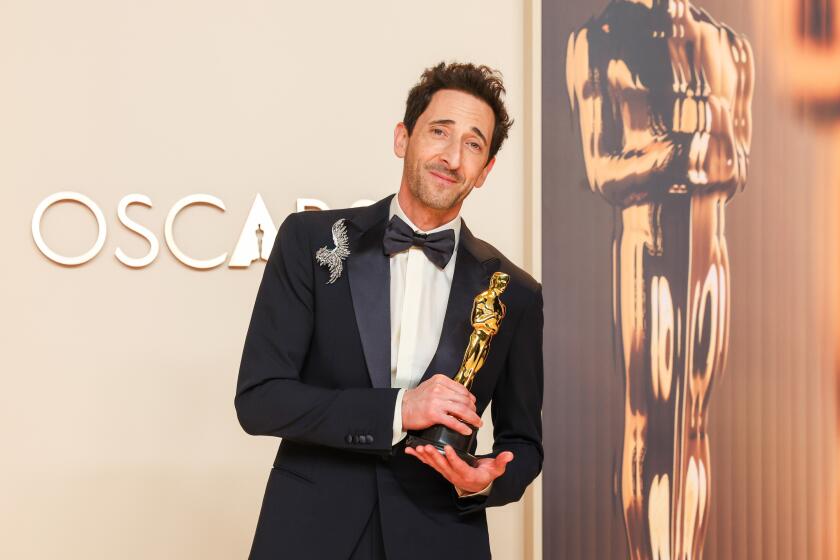A Perplexing Equation
- Share via
Recoveries from affliction, life-affirming triumphs of the human spirit, are catnip for Hollywood, and few stories fit that model as cozily as the life of mathematician John Forbes Nash Jr.
As detailed in the Sylvia Nasar biography that gives “A Beautiful Mind” its title, Nash was a brilliant mathematician, a handsome solver of impossible problems who was one of his generation’s towering theoretical figures.
Then began a catastrophic 30-year interlude of intense paranoid schizophrenia that ended, even more astonishingly, with a remission that was capped by a share of the 1994 Nobel Prize in economics.
Although it would be satisfying to report that “A Beautiful Mind,” which stars Russell Crowe as the mathematician and Jennifer Connelly in a career-best performance as his beleaguered wife, also beat the Hollywood odds and is a potent treatment of a serious, adult theme, the reality is not that clear-cut.
There is more to admire in “A Beautiful Mind” than you might suspect, but less than its creators believe. When the film does succeed, it almost seems to do so despite itself, at those moments when the power of the underlying story structure and the strength of the actors overcome the film’s inevitable weakness for hitting things too much on the nose.
This is probably the most successfully serious film director Ron Howard has ever done, but at the end of the day it’s still too much a too-tidy Ron Howard project, and it is in the space between those two statements that this picture’s true nature lies.
Interestingly, “A Beautiful Mind’s” relation to Nash’s story is also more complex than it might appear. Screenwriter Akiva Goldsman and director Howard are candid about the way their film is what biographer Nasar describes as “a highly stylized dramatization rather than a literal retelling” of those events, in which everything from the nature of Nash’s incapacitating delusions to the shape of his marriage has been changed for dramatic effect.
This typical have-your-cake-and-eat-it-too attitude is not a problem in and of itself, but it at times fosters the film’s unfortunate tendency to repackage an unusual story as a standard brand.
Certainly there is nothing standard about young Nash when he begins his mathematical graduate studies at Princeton in 1947. Known almost immediately as “the mysterious West Virginia genius,” Nash is simultaneously arrogant and shy, cocky and tongue-tied. “I don’t like people much and they don’t much like me” is his accurate self-description. In fact, the only friend he makes is the roommate he doesn’t expect to have, Charles Herman (Paul Bettany, Chaucer in “A Knight’s Tale”), a heavy-drinking fan of D.H. Lawrence.
If Nash has no time for small talk or social graces, its because he lives and breathes math, scribbling equations on windows and oozing determination to make a mark for himself, to come up with a truly original idea. Even at this early stage he is wound too tight, but it all seems worthwhile when he comes up with a game theory formulation known as the Nash Equilibrium. He does this, in a typical show-biz touch, while trying to figure out the best way for a group of friends to pick up women in a bar.
It’s six years later, with Nash established at MIT’s prestigious Wheeler Defense Lab, that he makes two connections that determine the shape of the rest of his life. First is the sinister William Parcher (Ed Harris), a black-hatted government intelligence operative straight out of Gang Busters who involves the mathematician in top-secret security work that could have monumental implications.
On the more humane side, there is one of Nash’s students, Alicia Larde, the bright and beautiful young woman he marries, who seems more amused than unhorsed by Nash’s prickly, uncompromising mental powers. This relationship parallels and draws its strength from the byplay between Crowe and Connelly, an interaction that is one of the film’s strongest points.
Crowe is an actor capable of conveying simultaneous arrogance and diffidence, and even though his West Virginia accent seems like a bit of a stunt, he is someone we always want to watch, a forceful performer whose strength has regularly blown co-stars off the screen.
Connelly, however, doing easily her most confident and impressive work ever, is completely his match here, just as Alicia is John’s in life. There’s an intelligence and a tartness to her performance, an ability to be energized rather than fazed or intimidated by her co-star’s powers, that leads to a noticeable on-screen sizzle between them.
Screenwriter Goldsman, whose credits include two Batman movies and “Lost in Space,” had a special reason to be drawn to this film. According to the press notes, his parents had “founded one of America’s first ‘group homes’ for emotionally disturbed children.” With that experience to draw on, Goldsman came up with a different and effective technique for conveying Nash’s schizophrenia that is the film’s most interesting aspect.
Other parts of “A Beautiful Mind,” including the film’s often pedestrian dialogue and flimsy characterizations of minor characters, are not as effective. Though Howard has said he was determined that this film “not be a sentimentalized look at this man’s life,” that tendency is too much a part of the director’s temperament to be completely eliminated, no matter how righteous his intentions. Just as Nash’s saner thoughts fought with his illness, those two inclinations fight for control of “A Beautiful Mind,” with a clear victory not in sight.
*
MPAA rating: PG-13, for intense thematic material, sexual content and a scene of violence. Times guidelines: may be too disturbing for younger audiences.
‘A Beautiful Mind’
Russell Crowe...John Nash
Ed Harris...Parcher
Jennifer Connelly...Alicia Nash
Paul Bettany...Charles
Christophe Plummer...Dr. Rosen
Universal Pictures, DreamWorks Pictures, Imagine Entertainment present a Brian Grazer Production, released by Universal Pictures. Director Ron Howard. Producers Brian Grazer, Ron Howard. Executive producers Karen Kahela, Todd Hallowell. Screenplay Akiva Goldsman, based on the book by Sylvia Nasar. Cinematographer Roger Deakins. Editors Mike Hill, Dan Hanley. Costumes Rita Ryack. Music James Horner. Production design Wynn Thomas. Art director Robert Guerra. Set decorator Leslie Rollins. Running time: 2 hours, 9 minutes.
In general release.
More to Read
Only good movies
Get the Indie Focus newsletter, Mark Olsen's weekly guide to the world of cinema.
You may occasionally receive promotional content from the Los Angeles Times.











